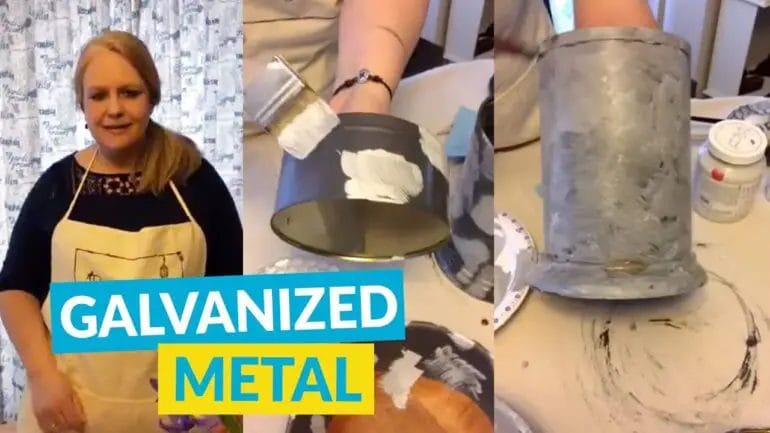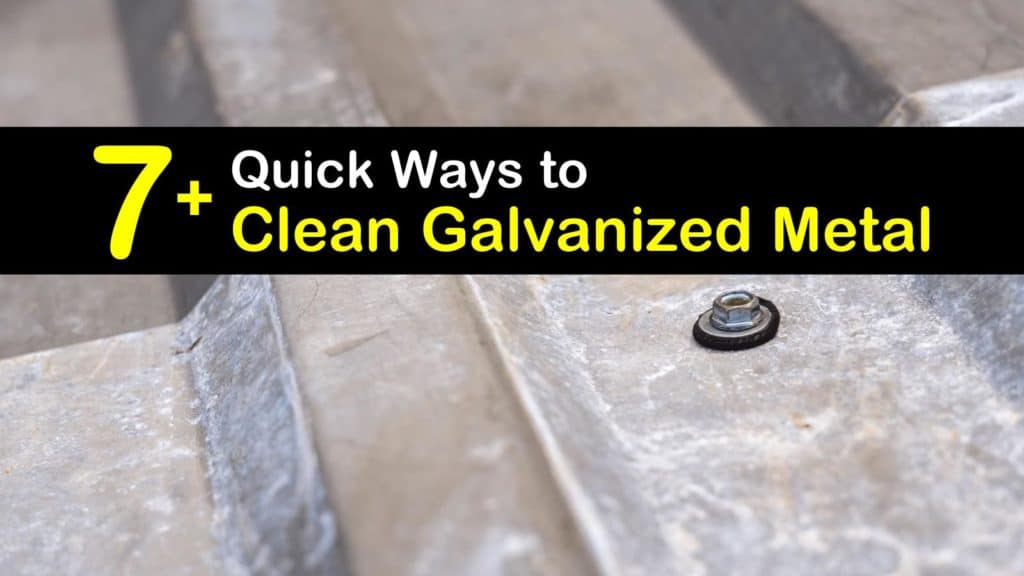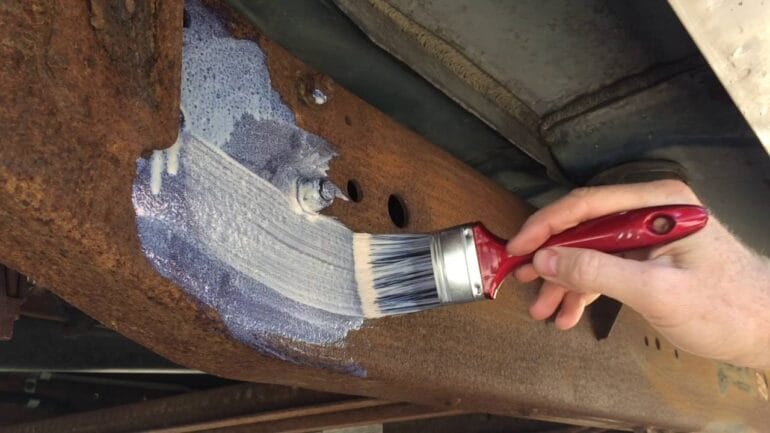If you’re looking for a way to remove paint from galvanized metal, you’ve come to the right place.
Removing paint from galvanized metal can be a tricky task, as traditional paint removers may not be effective and could damage the surface.
Fortunately, there are safe and efficient methods to remove paint from galvanized metal without causing any harm.
In this guide, we will explore some effective techniques and tools that will help you achieve paint-free and pristine galvanized metal.
Whether you’re dealing with a small paint spill or an entire painted surface, we’ve got you covered with step-by-step instructions and expert tips.
Read on to discover the best practices for removing paint from galvanized metal and restore its original beauty.

Step-by-Step Guide to Safely Strip Paint from Galvanized Metal
If you have a piece of galvanized metal that is covered in old, peeling paint, you may be wondering how to properly strip the paint without damaging the galvanized surface. It’s important to follow the correct steps to ensure the paint is removed safely and effectively. In this guide, we will walk you through the process step-by-step to help you strip paint from galvanized metal without causing any harm.
Materials You Will Need:
- Protective goggles
- Protective gloves
- Respirator mask
- Paint scraper
- Soft-bristle brush
- Paint stripper
- Mineral spirits
- Wire brush
- Water
- Rags
Step 1: Prepare the Work Area
Before starting the paint stripping process, it’s important to prepare your work area. Make sure you are in a well-ventilated space or work outside to avoid inhaling any fumes. Lay down a drop cloth or newspaper to protect the surrounding area from paint chips and debris.
Step 2: Put on Protective Gear
Safety should always be a priority when working with chemicals and tools. Put on a pair of protective goggles, gloves, and a respirator mask to protect your eyes, hands, and respiratory system from any potential hazards.
Step 3: Test the Paint Stripper
Before applying the paint stripper to the entire surface, it’s important to test it on a small, inconspicuous area of the galvanized metal. This will help ensure that the paint stripper is compatible with the surface and won’t cause any damage or discoloration.
Step 4: Apply the Paint Stripper
Once you have confirmed that the paint stripper is safe to use, apply a thick and even layer of the stripper onto the painted surface. Use a paintbrush or a roller to apply the stripper, making sure to cover the entire area that needs to be stripped. Follow the manufacturer’s instructions for the recommended application time.
Step 5: Scrape off the Paint
After the paint stripper has had time to penetrate the paint, use a paint scraper to gently scrape off the softened paint. Work in small sections and be careful not to apply too much pressure. If needed, reapply the paint stripper to stubborn areas and let it sit for a bit longer before scraping.
Step 6: Remove Residual Paint
Once you have removed the majority of the paint, use a soft-bristle brush dipped in mineral spirits to clean off any residual paint and stripper from the galvanized metal. This will help ensure that the surface is fully clean and ready for the next steps.
Step 7: Scrub with a Wire Brush
To remove any remaining paint or stubborn spots, gently scrub the surface with a wire brush. Be cautious not to scrub too hard or use a wire brush with bristles that are too stiff, as this may cause damage to the galvanized metal.
Step 8: Rinse and Dry
Once you have successfully removed all the paint, thoroughly rinse the galvanized metal with water to remove any remaining traces of the paint stripper, mineral spirits, and debris. Use a clean cloth or towel to dry the surface completely before proceeding with any further treatments or coatings.
Step 9: Dispose of Waste Properly
When dealing with paint stripper, it’s important to dispose of the waste properly. Follow the instructions on the product label or check with your local waste management facility for guidelines on how to dispose of any leftover paint stripper, paint chips, or other related materials.
Step 10: Apply Protective Coating (Optional)
Once the galvanized metal is completely clean and dry, you may consider applying a protective coating to prevent future paint adherence and corrosion. Consult a professional or refer to the manufacturer’s recommendations for the appropriate coating to use for your specific application.
Summary
Stripping paint from galvanized metal requires careful preparation and the use of proper tools and materials. By following this step-by-step guide, you can safely remove paint from galvanized

Powerful Chemical Solutions for Removing Paint from Galvanized Metal
If you have a piece of galvanized metal that has been painted and you want to remove the paint without damaging the underlying galvanized coating, you’ll need to use a powerful chemical solution. Galvanized metal is coated with a layer of zinc to protect it from corrosion, and traditional paint removers may not be effective or may cause damage to the galvanized surface. In this section, we will explore some powerful chemical solutions that are specifically designed to remove paint from galvanized metal.
1. Citric Acid
Citric acid is a popular and effective chemical solution for paint removal from galvanized metal. It is a natural acid found in citrus fruits and is commonly used in various cleaning applications. Citric acid works by breaking down the chemical bonds between the paint and the metal, making it easier to remove the paint.
To use citric acid for paint removal, mix a solution of citric acid and water in a container according to the manufacturer’s instructions. Apply the solution to the painted surface and let it sit for a few minutes to allow the citric acid to work. Then, scrub the surface with a brush or a sponge to remove the loosened paint. Rinse the surface thoroughly with water to remove any residue.
2. Phosphoric Acid
Phosphoric acid is another powerful chemical solution that can be used to remove paint from galvanized metal. It is commonly found in rust removers and can effectively dissolve paint without damaging the galvanized coating.
To use phosphoric acid for paint removal, dilute the acid with water according to the manufacturer’s instructions. Apply the solution to the painted surface and let it sit for a few minutes. Scrub the surface with a brush or a sponge to remove the paint. Rinse the surface thoroughly with water to neutralize the acid and remove any residue.
3. Sodium Hydroxide
Sodium hydroxide, also known as caustic soda or lye, is a strong alkaline compound that can be used to remove paint from galvanized metal. It works by breaking down the paint and making it easier to remove.
When using sodium hydroxide for paint removal, it is important to take proper safety precautions as it is highly corrosive. Wear protective gloves and goggles to protect your skin and eyes. Mix a solution of sodium hydroxide and water in a well-ventilated area, following the manufacturer’s instructions. Apply the solution to the painted surface and let it sit for a few minutes. Scrub the surface with a brush or a sponge to remove the paint. Rinse the surface thoroughly with water to neutralize the sodium hydroxide and remove any residue.
4. Paint Strippers Specifically Designed for Galvanized Metal
There are also paint strippers available in the market that are specifically designed for removing paint from galvanized metal. These paint strippers are formulated to be effective on galvanized surfaces without causing damage to the underlying coating. They usually come in gel or paste form and can be applied directly to the painted surface.
Before using any paint stripper, always read the manufacturer’s instructions and follow the safety precautions. Apply the paint stripper to the painted surface and let it sit for the recommended amount of time. Use a scraper or a brush to remove the loosened paint. Rinse the surface thoroughly with water to remove any residue.
Summary
If you need to remove paint from galvanized metal, it is important to use a powerful chemical solution that is specifically designed for this purpose. Citric acid, phosphoric acid, sodium hydroxide, and paint strippers specifically designed for galvanized metal are some effective options to consider. Always follow the manufacturer’s instructions and take proper safety precautions when using these chemical solutions. Remember to rinse the surface thoroughly after paint removal to ensure the complete removal of any residue.

Top Tips for Removing Paint from Galvanized Metal without Damaging the Surface
If you have galvanized metal surfaces that are covered in peeling or unwanted paint, it’s important to know how to remove the paint effectively without causing any damage to the underlying galvanized coating. Here are some top tips to help you remove paint from galvanized metal surfaces without compromising their durability or appearance.
1. Choose the Right Chemical Strippers
Chemical strippers are effective in removing paint from galvanized metal surfaces, but it’s crucial to choose the right products that are safe for galvanized coatings. Look for strippers specifically formulated for use on galvanized surfaces and follow the manufacturer’s instructions carefully.
2. Test an Inconspicuous Area
Before applying any chemical stripper or method on the entire metal surface, test it on a small, inconspicuous area. This will help you determine if the stripper is safe to use and if it effectively removes the paint without damaging the galvanized coating.
3. Use Mechanical Methods
If you prefer a non-chemical approach, there are mechanical methods you can try to remove paint from galvanized metal. Scrubbing with a wire brush or using sandpaper can be effective, but be cautious to avoid scratching the galvanized surface.
4. Apply Heat
Heat can be used to soften the paint and make it easier to remove. You can use a heat gun or a blowtorch to carefully heat the painted area until the paint begins to bubble or blister. Once softened, gently scrape off the paint using a putty knife or scraper.
5. Use Solvents
Solvents like paint thinner or acetone can be effective in removing paint from galvanized metal. Apply the solvent to a cloth or sponge and gently rub the painted area until the paint starts to dissolve. Remember to work in a well-ventilated area and wear protective gloves.
6. Pressure Washing
If the paint is not heavily layered, pressure washing can be a quick and efficient way to remove it from galvanized metal. Use a pressure washer with a wide-angle nozzle and start with low pressure to avoid damaging the galvanized surface. Gradually increase the pressure until the paint is removed.
7. Seek Professional Help
If you are unsure or uncomfortable with removing paint from galvanized metal yourself, it’s best to seek professional help. They have the expertise and specialized tools to safely remove the paint without causing any damage to the galvanized coating.
8. Protect the Galvanized Surface
Once the paint is successfully removed, it’s important to protect the galvanized surface to prevent future paint adherence. Apply a galvanized metal primer or a zinc-rich paint to protect the metal from corrosion and provide a suitable surface for paint adhesion, if desired.
Summary
Removing paint from galvanized metal without damaging the surface requires careful consideration and the right techniques. Whether you choose chemical strippers, mechanical methods, or heat and solvents, it’s crucial to test and proceed cautiously to preserve the integrity of the galvanized coating. If unsure, it’s always best to seek professional assistance to ensure the job is done safely and effectively.
Expert Techniques to Restore the Original Appearance of Galvanized Metal by Removing Paint
Galvanized metal is a popular choice for various applications due to its durability and corrosion resistance. Over time, however, paint can accumulate on galvanized surfaces, diminishing their original appearance. If you’re looking to restore the pristine look of galvanized metal, there are several expert techniques you can employ to effectively remove paint. In this section, we will explore these techniques in detail.
1. Chemical Stripping
Chemical stripping is a widely used method for removing paint from galvanized metal. This technique involves the application of a chemical paint stripper that breaks down the bond between the paint and the metal surface. To use this method, you’ll need to follow these steps:
- Prepare the work area by covering it with a drop cloth or newspaper to catch any drips or spills.
- Wear protective gloves and eyewear to minimize contact with the chemical stripper.
- Apply a generous amount of the paint stripper onto the painted areas using a brush or roller.
- Allow the stripper to sit on the surface for the recommended time specified by the manufacturer.
- Use a scraping tool or a wire brush to gently remove the softened paint from the galvanized metal.
- Repeat the process if necessary to remove all traces of paint.
- Once the paint is removed, clean the surface with water and a mild detergent to remove any residue.
- Dry the metal thoroughly before applying any protective coating or paint.
2. Mechanical Methods
If the paint on your galvanized metal is stubborn and resistant to chemical stripping, you can resort to mechanical methods to remove it. Here are a few techniques you can try:
- Scraping: Use a scraper or putty knife to gently scrape off the paint from the surface. Be cautious not to scratch the galvanized coating underneath.
- Sanding: Employ sandpaper or a sanding block to sand away the paint. Start with a coarser grit to remove the bulk of the paint, then switch to a finer grit to smoothen the surface.
- Wire Brushing: Brush the painted areas with a wire brush to loosen the paint. This method works well for smaller patches of paint or hard-to-reach areas.
- Power Tools: If you have a large area to cover, you can use power tools such as a drill with a paint-removing attachment or a power sander to expedite the paint removal process.
After employing any of the mechanical methods, be sure to clean the surface thoroughly and remove any dust or debris before proceeding with any further treatments.
3. Heat Stripping
Heat stripping is another effective technique for removing paint from galvanized metal. This method involves using heat to soften the paint, making it easier to scrape off. Here’s how you can utilize heat stripping:
- Equip yourself with heat-resistant gloves and safety glasses to protect yourself from any potential hazards.
- Use a heat gun or a blowtorch to apply heat to the painted areas. Keep the heat source moving to prevent overheating or damaging the galvanized coating.
- As the paint softens, gently scrape it off using a scraper or putty knife. Be cautious not to apply excessive pressure that could harm the metal surface.
- Repeat the process until all the paint is removed.
- Once the paint is gone, clean the surface with water and a mild detergent to remove any residue.
- Dry the metal thoroughly before applying any protective coating or paint.
It’s important to note that heat stripping can be more time-consuming and potentially hazardous, so exercise caution and follow safety guidelines when using this method.
4. Chemical Paint Removers
If you prefer using a less aggressive approach, there are chemical paint removers specifically designed for removing paint from galvanized metal. These products are milder than traditional paint strippers and are less likely to damage the galvanized coating. Before using a chemical paint remover, be sure to carefully read and follow the manufacturer’s instructions for optimal results.
In summary, restoring the original appearance of galvanized metal by removing paint can be achieved through various expert techniques. Whether you opt for chemical stripping, mechanical methods, heat stripping, or specialized paint removers, it’s essential to
FAQs
1. How can I remove paint from galvanized metal?
To remove paint from galvanized metal, start by cleaning the surface with a mixture of warm water and mild detergent. Then, use a scraper or wire brush to gently remove the loose paint. If necessary, you can also use a paint stripper specifically designed for metal surfaces. Remember to follow all safety instructions and wear protective gear when using chemical paint strippers.
2. Can I use a chemical paint remover on galvanized metal?
Yes, you can use a chemical paint remover on galvanized metal. However, it is important to choose a paint remover specifically formulated for use on metal surfaces. Read and follow the product instructions carefully, and always wear protective gear to avoid contact with the chemicals.
3. Will sanding remove paint from galvanized metal?
Sanding can be effective in removing paint from galvanized metal, but it may also damage the galvanized coating. If you choose to sand the surface, use fine-grit sandpaper and apply light pressure. Be careful not to rub off or damage the protective galvanized layer. It’s recommended to test a small inconspicuous area first before proceeding.
Conclusion
Removing paint from galvanized metal can be a challenging task, but with the right techniques and tools, it can be done effectively. By using methods such as chemical paint strippers, heat guns, or sanding, you can eliminate the unwanted paint and restore the natural beauty of the galvanized metal.
Remember to take necessary safety precautions and follow the manufacturer’s instructions when using chemical paint strippers or heat guns. Additionally, consider using a rust-inhibiting primer or a protective coating after removing the paint to prevent future paint peeling or rusting.
With patience and persistence, you can achieve a successful paint removal from galvanized metal and enjoy a clean and pristine surface once again.
